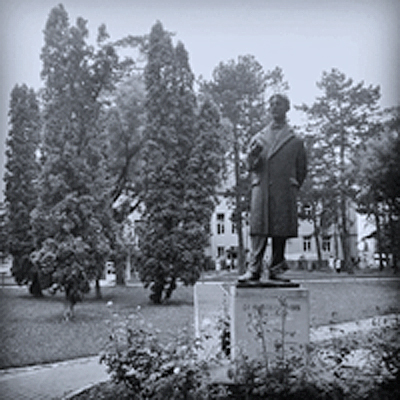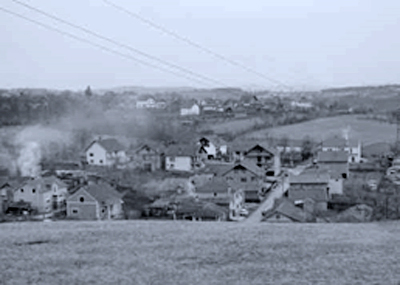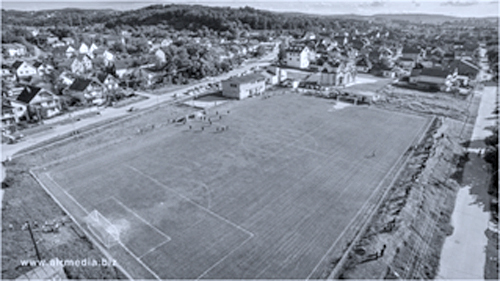| |
Download in pdf format |
|
Serbian physician and
politician, dr. Mihailo Ilic was a historical figure and a famous
person with a well deserved memorial at Clinical Center "Kragujevac"
in Kragujevac, Figure 1. Famous Serbian doctor was born in 1856 in
the village of Meckovac near Kragujevac, which is called Ilicevo
today (until 1954, the village was called Meckovac) (the origin of
the population of the village of Meckovac as the City of Vranje -
Pcinjski district, according to the book of John F. Trifunoski "Vranjska
Kotlina", based on data collected from 1951 to 1955, prepared by an
associate of Porekla Milodan) [1]. Figure 1.
Monument of serbian physician and politician, dr. Mihailo Ilic
(1856-1905)
Clinical Center "Kragujevac" of Kragujevac

Best Kragujevac images|Serbian
https://www.pinterest.com/SlavicTravels/kragujevac/
Dr. Mihailo Ilic was born in the Principality of Serbia, which
lasted from 1815 to 1882. It was created after the Second Serbian
Uprising and existed until 1882 when it was declared the Kingdom of
Serbia [1].
Ilic's birthplace, Meckovac, belonged to the citymunicipality of
Pivara from 2002 to 2008, and after that time, the municipalities
were dissolved. It is located east of the center of Kragujevac. Due
to immediate proximity of the city, and a large population growth of
the village of Meckovac, there was a clear physiognomic fusion of
this settlement with Kragujevac. Ilićevo was initially an
independent settlement, and in 1991 it was officially dissolved as
an independent settlement and annexed to Kragujevac (as a local
community in the city of Kragujevac) [1,2]. The settlement was first
mentioned as Mickovaz, during Austrian occupation of Serbia, in the
period 1718-1739. Meckovac had been primarily settled closer to the
road and before the first Serbian uprising it was translocated. One
historical reason for the translocation were frequent devastations
caused by janissaries, as the settlement was located on a busy
Kragujevac road. Another, demographic reason was a frequent
overflowing of Lepenica, which flooded many buildings and the
surrounding area. At the beginning of the nineteenth century in
Serbian historical sources, this place was mentioned several times,
as Meckovac. This was not the case with many foreign authors. By
Riddle, in 1810, it was registered as Mescovacz, on Lapi's map in
1822 as Metskovatz, by Fried's in 1829 as Meskovacz, and by Kipert's
as Metschkowats [2]. According to the census in 1903, Meckovac had
356 and seven years later – 48 inhabitants. In 1954, Meckovac
changed its name to Ilicevo. It was named after a great Serbian
doctor and member of Serbian Social Democratic Party, dr. Mihailo
Ilic, who was born in Meckovac in 1856.. In his honour, his
birthplace changed its name to Ilićevo, which was part of the city
municipality of Pivara in Kragujevac [2]. After the first World War,
Ilicevo had 515 inhabitants, which was unusual for a , e place on
the banks of the Lepenica to have more inhabitants after the first
World War. Ilicevo’s territory is located in the central part of
Serbia, in the eastern part of Sumadija and covers the catchment
area of the middle flow of the Lepenica river. Ilicevo also spreads
on both sides of a dry stream called Bara, which flows only after
heavy rains, otherwise the riverbed has no water. That is why it is
called the "Dry Stream". On the northwestern side of the townarea
there flows the Lepenica, and on the west side there passes
Kragujevac road and Lapovo - Kragujevac – Kraljevo railway, but
there is no a train station there [2]. Just next to Ilicevo is the
State Road IB 24, Batocina - Kragujevac, which is being turned
(final construction in progress) into Kragujevac - Batocina Highway,
Figure 2.
Figure 2. Ilicevo

Photo: The origin of the population of the village of Ilicevo (until
1954 Meckovac), City Municipality of Pivara, the City of Kragujevac
- Sumadija District. (according to the books by Todor Radivojevic "Lepenica"
and "Settlements in Lepenica". Prepared by an associate of Porekla
Milodan).
A PATRIOT'S BIOGRAPHY
Mihailo Ilic was a famous and good physician. By the end of the 19th
century, Kragujevac had changed several district physicians: Filip
Tajsic (1865), Leonard Leontkievich (1880), Djura Gavric (1885),
Ilija Kolovic (1891), amd Stevan Siber (1897). Dr. Mihajlo Ilić came
to Kragujevac at the begining of the 20th century. Besides
dedicated, professional medical service at the Military Technical
Institute, he became the first deputy of the Social Democratic Party
in 1905 [3]. In 1903, dr Mihailo Ilic became a member of the Serbian
Social Democratic Party (SSDS). The Serbian Social Democratic Party
was a political party, which operated in the Kingdom of Serbia and
the Kingdom of Serbs, Croats and Slovenes, from 1903 to 1919. In
parliamentary elections (September 8, 1903), dr Mihailo Ilic was
elected a member of parliament (MP) of Kragujevac district. He was
the only SSDS-MP in the National Assembly of the Kingdom of Serbia,
and the first Social Democrat-MP in Serbian's history. In the short
span of its activities and during the annexation crisis (Balkan
wars, and the period before the First World War), this party
implemented an anti-war program based on the idea of class
revolution and unification of the Balkan peoples into a
Confederation. The Social Democratic Party of Serbia entered
European history as the only party to vote against the war budget
before the Great War [3]. In 1966, "Dr. Mihailo Ilic" Medical Center
was established in Kragujevac. From 1975 Medical Center was
reorganized into seven BOALs (Basic Organisations of Associated
Labour). In 1986, BOAL "Hospital" was separated as Clinical Hospital
Centre of Kragujevac, and the others continued to work as the
Medical Center "Dr Mihailo Ilić", which in 1991 grew into the Health
Center "Dr Mihailo Ilić". Clinical Hospital Centre of Kragujevac
grew into Clinical Center of Kragujevac on 4 November 2005, as
tertiary level of healthcare [3,4]. Dr. Mihailo Ilic died on October
22 (October 9, according to the Old Calendar) in Kragujevac, at the
age of 48. He died at the time of the Kingdom of Serbia former
official name of the state of Serbia), between 1882 and 1918. Serbia
was proclaimed Kingdom by the decision of the National Assembly on
March 6, 1882, which elevated the Principality of Serbia to the
status of Kingdom [4]. Until the Second World War, many private
dentists worked in Kragujevac. After the war, along with the
development of other outpatient medical services, the dental service
developed, too. This service operated within the Health Center and
after the creation of the medical center ''Dr. Mihailo Ilic'' it was
formed as one of its services. By the decree of the Government of
the Republic Serbia in 1998, a decision was passed whereby the
dental service was separated from the Health Center of Kragujevac,
as an independent institution, with the name: Institute of Dentistry
of Kragujevac [5]. Primary health care in Kragujevac was established
as a separate functional form in 1966 as the Medical Center of
Kragujevac's. Until 1990, this institution functioned within the
BOAL ‘’Dom zdravlja’’ (Health Center). Since 1990, the Medical
Center was established as "Dr. Mihailo Ilic" Health Center, a part
of which was the Health Center in Kragujevac. In its present form
the Health Center in Kragujevacwas established in 1998 by a decree
of the Government of the Republic Serbia. The history of health
culture in Kragujevac and its impact on contemporary healthcare of
this area was recognizably identified by the stature of "Dr. Mihailo
Ilic", a famous figure of a great Serbian physician and politician
[6]. And one of the most famous football clubs on the outskirts of
the city of Kragujevac - "Serbia" from Ilicevo, has been celebrating
more than eight decades since its founding. Nobody knows exactly
when this club was founded, but everyone agrees that it was in the
summer of 1935. The club was primarily named "Meckovac", which was
renamed to Ilicevo in the memory of dr. Mihailo Ilic, the first
Social Democrat-MP in the Balkans. In 1970, the club was named
"Serbia" (pretty brave and radical move at that time), but with a
curiosity, that it is now the only football club of that name in
Serbia (not counting Diaspora and other sports teams) [7], Figure 3.
Figure 3. The stadium of the football club
"Serbia" in Ilicevo

Foto -
www.alcmedia.biz
In conclusion: Dr. Mihail Ilic's national contribution lies in
that many institutions of his time and even today, such as places,
institutions, sports clubs, streets in Kragujevac bear his name; and
as a token of eternal gratitude, in order not to forget the good
deeds of a military doctor, an his anti-war political orientation
and the proper policies of the first Social Democrat member of
parliament in the Balkans and in Serbian history in general. Dr.
Mihail Ilic died as relatively young man, and we cannot rightly
judge and analyze other contributions in the field of health culture
and healthcare by a famous, Serbian patriot, physician and
politician.
REFERENCES:
- Srpski biografski rečnik (knjiga četvrta). „Matica srpska“,
Novi Sad, 2009. godina.
- Todor Radivojević: „Naselja u Lepenici“ i „Lepenica“;
Vikipedija, Београд, 1907.
- Matović DZ. 150 godina Kragujevačke bolnice. Hronika prve
stalne bolnice u Srbiji. Kragujevac: Okružna podružnica Srpskog
lekarskog društva, Kragujevac, 2010.
- Arhiva. Kragujevac: Klinički centar „Kragujevac“,
Kragujevac, 2012.
- Arhiva Muzeja zdravstvene kulture. Kragujevac: Klinički
centar „Kragujevac“, Kragujevac, 2012.
- Ružić Z, Nedeljković R, i sar. Istorija zdravstvene kulture
Kragujevca i njen uticaj na savremenu zdravstvenu zaštitu ovog
područja. Med Čas. 1998; 1-2: 40-49.
- http://www.kragujevacke.rs/društvo ilićevo
|
|
|
|



